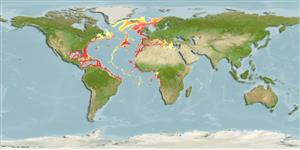Classification / Names
Common names from other countries
Issue
This species is often confused with Nezumia sclerorhynchus (Valenciennes, 1838).
Main reference
Size / Weight / Age
Max length : 36.0 cm TL male/unsexed; (Ref. 3587); common length : 25.0 cm TL male/unsexed; (Ref. 2683); max. reported age: 9 years (Ref. 58045)
Length at first maturity
Lm 4.5, range 4 - ? cm
Environment
Marine; benthopelagic; non-migratory; depth range 200 - 2320 m (Ref. 3587), usually 200 - 1000 m (Ref. 2683)
Climate / Range
Deep-water, preferred 23°C (Ref. 107945); 70°N - 12°S, 98°W - 30°E (Ref. 1371)
Distribution
Atlantic Ocean: Eastern Atlantic: Faroe Bank to northern Angola and the Mediterranean Sea. Western Atlantic: Davis Straits to northern Brazil.
Countries | FAO areas | Ecosystems | Occurrences | Introductions
Short description
Dorsal
spines
(total): 2;
Anal
spines: 0. Head short, completely scaled except for naked strip on the ventral surface of the snout; Eyes relatively large, 29 to 42% of head length; snout short, pointed; chin barbel very short. Body scales with lanceolate to shield-shaped spinules. Overall color is bluish to violet, head somewhat tawny to swarthy; ventral portions silvery when fresh; pelvic fins black except outermost ray which is pale to white; oral cavity grayish; branchial cavity mostly black.
IUCN Red List Status (Ref. 115185)
Threat to humans
Harmless
Human uses
Fisheries: minor commercial
Tools
Special reports
Download XML
Internet sources
Estimates of some properties based on models
Phylogenetic diversity index
PD50 = 0.5000 many relatives (e.g. carps) 0.5 - 2.0 few relatives (e.g. lungfishes)
Trophic Level
3.3 ±0.1 se; Based on diet studies.
Resilience
Medium, minimum population doubling time 1.4 - 4.4 years (Preliminary K or Fecundity.)
Vulnerability
Moderate vulnerability (44 of 100)
Price category
